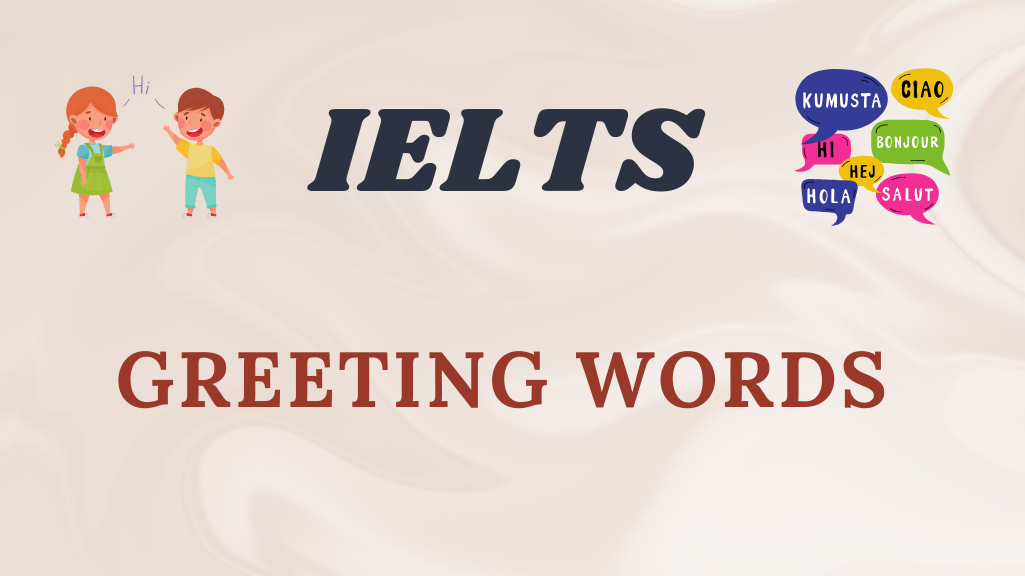"Hello!" "Good morning!" "How do you do?"
These simple yet powerful words form the basis of human interaction. Whether you’re meeting someone for the first time, greeting a friend, or starting a conversation in a formal setting, your choice of greeting sets the tone for the interaction.
In the IELTS Speaking test, the way you greet the examiner might not directly impact your score, but it certainly helps establish confidence and fluency. In both casual and professional settings, greeting words help you build rapport and show cultural awareness.
This guide will take you through the different types of greetings—formal, informal, and slang—along with cultural variations and their relevance in the IELTS exam.
What Are Greeting Words?
A greeting word or phrase is an expression used to acknowledge someone’s presence and establish a connection. These words can be used in spoken and written communication, playing a crucial role in setting the tone of an interaction.
In English, greetings can range from highly formal, such as “It’s a pleasure to meet you,” to extremely casual, like “Hey!” The right choice depends on the situation, the relationship between speakers, and cultural expectations.
For instance, saying “What’s up?” to your IELTS examiner might not be appropriate, whereas greeting a friend with “Good afternoon, sir” could sound overly formal and unnatural. Understanding these nuances is essential for effective communication.
Informal Greetings
Informal greetings are what you use when you're comfortable with someone—friends, family, or even colleagues in a laid-back setting. These greetings are casual, fun, and often spontaneous, making conversations feel more natural and engaging.
Think about how you greet your best friend. You wouldn’t say, “Good afternoon, how do you do?” That would feel way too stiff. Instead, you’d go for something like, “Hey! What’s up?” or even just a simple “Yo!”

Unlike formal greetings, informal ones don’t require strict etiquette. You can shorten words (“Morning!” instead of “Good morning”), use slang (“What’s good?”), or even turn a greeting into a joke. These greetings reflect personality, culture, and shared experiences.
They also help create a relaxed and friendly atmosphere. If someone greets you with, “Hey man, long time no see!” instead of “Hello, it’s been a while,” it instantly makes the interaction feel warmer and more personal.
Common Situations for Informal Greetings
- Meeting a friend at a café
- Greeting a classmate in school
- Casual workplace conversations
- Social gatherings
Examples of Informal Greetings
- Hey!
- What’s up? (often shortened to "Wassup?")
- How’s it going?
- Nice to see you!
- Yo!
When using informal greetings, tone and body language play a big role. Saying “Hey” with a smile can feel warm and welcoming, while saying it with a monotone voice may seem uninterested.
While informal greetings are common in everyday conversations, they should be used carefully in IELTS. In Part 1 of the Speaking test, it’s fine to sound natural and friendly, but avoid overly casual phrases like “Yo!” or “Hey dude!”
Formal Greetings
Formal greetings are used in professional, academic, or respectful settings where politeness and etiquette matter. These are the greetings you’d expect in workplaces, official emails, or when addressing someone in a position of authority. Unlike casual greetings, formal ones often sound structured and grammatically complete, avoiding slang or overly familiar expressions.

Think about stepping into a boardroom meeting or greeting your professor—you wouldn’t casually say, “Yo, what’s up?” Instead, you’d go with a polished and professional greeting like, “Good afternoon, it’s a pleasure to meet you.” This sets the right tone and shows respect.
Formal greetings aren’t just about sounding professional; they also help build credibility in serious environments. When you greet someone formally, it signals that you take the conversation seriously and value professionalism.
Common Situations for Formal Greetings
- Job interviews
- Business meetings
- Speaking to elders or authority figures
- Writing official emails or letters
Examples of Formal Greetings
- Good morning/afternoon/evening.
- Pleased to meet you.
- How do you do?
- It’s an honor to meet you.
- Hello, [name]. How are you today?
Formal greetings are especially important in the IELTS Speaking test, where first impressions matter. Using a polite “Good afternoon, it’s nice to meet you” at the start of the exam can make you sound more confident and prepared.
During the Speaking test, stick to neutral or slightly formal greetings. A phrase like “Hello, how are you?” is safe and professional, whereas “Howdy!” or “Yo, what’s good?” would be too informal.
Slang and Regional Greetings
Slang greetings are often used among younger speakers or within specific cultural groups. While they can make conversations more dynamic and engaging, they may not always be understood globally.
Common Situations for Slang Greetings
- Talking to close friends
- Interacting in a specific cultural or regional setting
- Using local phrases in informal environments
Examples of Slang Greetings from Different Regions
- G’day, mate! (Australia)
- Howdy! (Southern USA)
- Sup? (Urban American slang for "What’s up?")
- Alright, mate? (UK)
- How’s the craic? (Ireland – "Craic" means fun or news)
Slang greetings can make your English sound more natural when used correctly, but in IELTS, it’s best to avoid them unless discussing cultural differences.
If asked about language and culture in Part 3 of the Speaking test, you can mention slang greetings as an interesting cultural aspect. For example:
"In my country, younger people often greet each other with ‘What’s up?’ instead of ‘Hello.’ It’s a casual way of checking in with friends.”
When to Use Different Greetings in IELTS

IELTS Speaking Part 1: Personal Introduction
- Best choice: Neutral or slightly formal greeting
- Example: “Good afternoon, it’s nice to meet you.”
IELTS Writing Task 1 (Formal Letter)
- Best choice: Very formal greeting
- Example: “Dear Sir/Madam” or “To Whom It May Concern”
IELTS Writing Task 1 (Informal Letter)
- Best choice: Casual but polite greeting
- Example: “Dear [friend’s name], Hope you’re doing well!”
IELTS Speaking Part 3: Discussion
- Best choice: Neutral or semi-formal greeting with clear, confident language
- Example: “That’s an interesting question. In my country, greetings vary depending on age and formality.”
Cultural Variations in Greetings
Different cultures have unique greeting customs that go beyond words. Some cultures use handshakes, while others prefer bows, nods, or even hugs. Being aware of these differences can improve your understanding of global communication.
Examples of Cultural Greeting Differences
- Japan: A bow is a common greeting, showing respect.
- France: A light kiss on both cheeks is a traditional greeting among friends.
- India: "Namaste" is used with a slight bow and folded hands.
- Middle East: Handshakes are common, but with the same gender.
If discussing cultural differences in IELTS Speaking Part 3, mentioning how greetings vary worldwide can showcase your ability to engage in complex discussions.
Choosing the Right Greeting
Still unsure whether to go formal or informal? Here’s a cheat sheet:
| Situation | Best Greeting |
|---|---|
| Job interview | "Good morning, it’s nice to meet you." |
| Talking to a professor | "Hello, how are you?" |
| Meeting a friend | "Hey! What’s up?" |
| Speaking to an IELTS examiner | "Good afternoon, how are you?" |
| Business meeting | "It’s a pleasure to meet you." |
| Casual chat with a classmate | "Hey, how’s it going?" |
